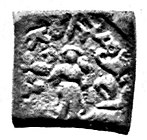Mitra dynasty (Mathura) | |||||||||||
|---|---|---|---|---|---|---|---|---|---|---|---|
| 150 BCE–50 BCE | |||||||||||
Left image: Coin of Gomitra of Mathura (reverse): Standing figure with symbols around, probably goddess Lakshmi.[1] Inscription Gomitasa in Brahmi.
Right image: Coin of Brahmamitra (reverse): Standing figure with raised arm, probably Lakshmi holding a lotus,[1] surrounded by symbols. Legend Brahmamitasa in Brahmi. | |||||||||||
| Capital | Mathura | ||||||||||
| History | |||||||||||
• Established | 150 BCE | ||||||||||
• Conquest of Mathura and Saketa by the Northern Satraps around 60 BCE | 50 BCE | ||||||||||
| |||||||||||
| Today part of | India | ||||||||||
The Mitra dynasty refers to a group of local rulers whose name incorporated the suffix "-mitra" and who are thought to have ruled in the area of Mathura from around 150 BCE to 50 BCE, at the time of Indo-Greek hegemony over the region, and possibly in a tributary relationship with them.[2][3][4] They are not known to have been satraps nor kings, and their coins only bear their name without any title, therefore they are sometimes simply called "the Mitra rulers of Mathura". Alternatively, they have been dated from 100 BCE to 20 BCE.[5] The Mitra dynasty was replaced by the Indo-Scythian Northern Satraps from around 60 BCE.
Some sources consider that the Mitra dynasty ruled at a later date, during the 1st or 2nd century CE, and that they ruled from Mathura to Saketa, where they replaced the Deva dynasty.[6]
In addition to the Mitra dynasties of Saketa (Kosala kingdom) and Mathura, there were Mitra dynasties in Ahichchhatra (Panchala kingdom) and Kaushambi (Vatsa kingdom). During the 1st century BCE to 2nd century CE, the Mitras of Kaushambi also appear to have extended their hegemony over Magadha (including Pataliputra), and possibly Kannauj as well.[7]
- ^ a b Paul, Pran Gopal; Paul, Debjani (1989). "Brahmanical Imagery in the Kuṣāṇa Art of Mathurā: Tradition and Innovations". East and West. 39 (1/4): 117. ISSN 0012-8376. JSTOR 29756891.
- ^ Quintanilla, Sonya Rhie (2007). History of Early Stone Sculpture at Mathura, ca. 150 BCE – 100 CE. BRILL. pp. 9–10. ISBN 978-90-474-1930-3.
- ^ Cite error: The named reference
Rhiewas invoked but never defined (see the help page). - ^ Indian Numismatic Studies K. D. Bajpai, Abhinav Publications, 2004, p.105 [1]
- ^ On the Cusp of an Era: Art in the Pre-Kuṣāṇa World, Doris Srinivasan BRILL, 2007, p.320 [2]
- ^ Ayodhya Revisited by Kunal Kishore p.24 [3]
- ^ K. D. Bajpai (October 2004). Indian Numismatic Studies. Abhinav Publications. pp. 37–39, 45. ISBN 978-81-7017-035-8.



